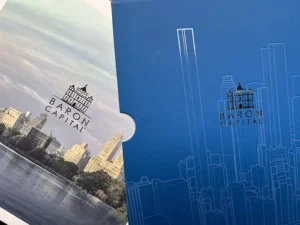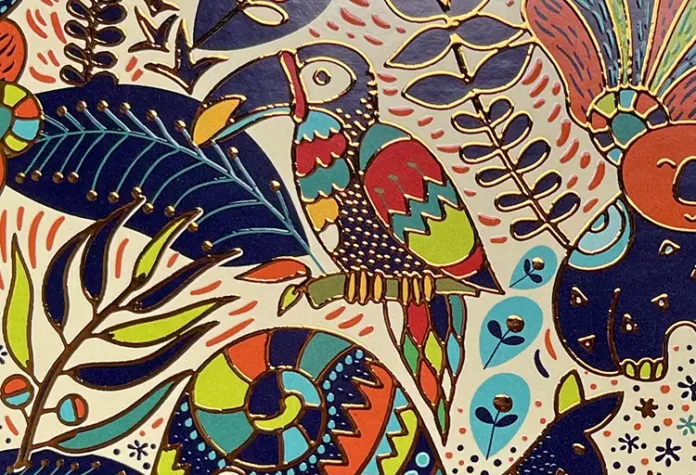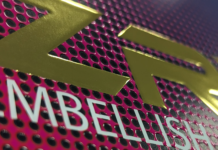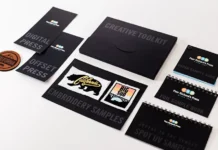By Jeff Peterson, editor-in-chief, PostPress
Digital embellishments are a growing segment of the total print embellishment industry. What has been interesting to see is that the growth has had little impact on most other embellishment techniques, such as hot and cold foil or screen spot UV coatings. Many of the digital applications have been on new projects for which, in the past, the designers likely would not have chosen foil or spot coatings based on run size.
Several current members of the Foil & Specialty Effects Association (FSEA) that have been traditional print finishers have stepped into the digital embellishment arena. They have found that, in many cases, selling digital embellishments takes a different approach than traditional methods. Kevin Abergel of Taktiful sat down with Steven Roberts, president, and Bryce Poremba, sales manager, at Elite Print Finishing in Burlington, North Carolina, to discuss the addition of digital embellishment technology at Elite and how it has been implemented into the current print finishing business.
How has the addition of digital embellishments to the operation opened up new business opportunities for Elite Print Finishing?
Roberts: There was a moment of “what just happened” when the JETvarnish was installed. It definitely has been a positive addition to Elite Print Finishing and for our team. There were a few challenges out of the gate, like anything, but it absolutely opened up new markets for us. It opened up new discussions with existing accounts prior to the new technology going in, and one of big positives was that it began feeding other processes downstream in our operation. It provided us more diecutting, film laminating and other processes – both on the commercial and packaging side.
 Poremba: I think Steven hit on it – it’s advanced our business in other ways. The JETvarnish has been awesome for me as a salesperson. We bought the press right before the COVID-19 pandemic, so as a salesperson I wasn’t able to get a lot of meetings set up. Having a new piece of technology with cool samples meant we were able to go in and show companies something they had never seen. All of a sudden, it gave us a reason to start a conversation, a reason for us to get on a Zoom® call and send out samples, a reason for us to get in the door. It was a great way in the door that also advanced our business in other ways as well. Overall, it was a blessing in disguise.
Poremba: I think Steven hit on it – it’s advanced our business in other ways. The JETvarnish has been awesome for me as a salesperson. We bought the press right before the COVID-19 pandemic, so as a salesperson I wasn’t able to get a lot of meetings set up. Having a new piece of technology with cool samples meant we were able to go in and show companies something they had never seen. All of a sudden, it gave us a reason to start a conversation, a reason for us to get on a Zoom® call and send out samples, a reason for us to get in the door. It was a great way in the door that also advanced our business in other ways as well. Overall, it was a blessing in disguise.
Roberts: It certainly re-energized what we were doing, and I think it had a very positive effect on our core customer base.
What specific markets or industries seem to be a good fit for this kind of finishing – meaning digitally-based embellishments?
Poremba: We definitely see some overlap with what we currently do, so it allows us to go to our current customers and have a new application – something that jumps off the shelf even more than what we’ve done in the past. However, it doesn’t work for everyone.
I would say the biggest space that we see growth in right now is probably the pharmaceutical and nutraceutical industries. There is so much competition on the shelf in those two industries that it seems like everybody is competing with each other to make the most vibrant and exciting carton. Sometimes the difference can be that embellishment, that person being able to pick it up and touch and feel 3D-raised coating on the front that really makes it stand out above the competition.
Roberts: A lot of brand owners are putting their product into a carton. So, the look of the carton, in a lot of cases, is going to build a perception that’s going to be the winner on the retail shelf. Shelf appeal is key.
College recruiting is another potential new market. All of these universities are competing, not just in football and basketball. They are competing to get students enrolled so they can capitalize on the dollars coming in. The touch and feel of the materials can be a huge selling point. With a lot of brands, they look at it as if it feels better, it must be better. That has been one of the biggest differences – that digital embellishments not only affect the visual sense but the touch sense as well.
One of the obstacles of offering digital embellishments is making sure the artwork is designed correctly. How has this challenge been handled when working with customers?
Poremba: It is a completely new technology, so there is a learning curve. I’m familiar with the technology and have been there through the hurdles as the press was new and we were learning how the different coatings go on different substrates or the different foils react better with certain things. I have a good understanding of the technology, but that’s still hard to sometimes translate to customers and their designers because it’s new.
 We have brought a designer on board who is 3D-certified. Sometimes it’s easier just to hand it over to that team member. And we have the customer connect over a Zoom meeting to answer questions, which we do for beginner projects. Our 3D designers have developed a generic PDF that converts to an artificial intelligence (AI) file and explains to our customers how to build a generic template with 3D varnish as well as 3D foil.
We have brought a designer on board who is 3D-certified. Sometimes it’s easier just to hand it over to that team member. And we have the customer connect over a Zoom meeting to answer questions, which we do for beginner projects. Our 3D designers have developed a generic PDF that converts to an artificial intelligence (AI) file and explains to our customers how to build a generic template with 3D varnish as well as 3D foil.
Elite Print Finishing offers a 3D certification program for designers. Explain what that is.
Roberts: It is a win-win situation. We are bringing designers into our facility and then having them qualified. At the end of it, they get a certificate that they can market to their customer base. And, subliminally, hopefully, Elite is getting better artwork out of the gate.
As with any process, there are limitations with digital embellishments. How can limitations, such as substrate choices and font size, be communicated by designers and buyers?
Poremba: From a broad perspective, the difficulty has been who we’re selling this technology to. In the past, as a trade finisher, our sales team has met with somebody who controls outsourcing for diecutting, foil stamping, etc. Many times, this is a buyer who is familiar with the technologies and knows our presses. It’s very simple, right?
Now we are having to go after either the sales team or the design team at our printing companies or packaging companies, and we’ve had to teach ourselves how to connect with those people. We have to change the way in which we sell to our customers.
Roberts: With foil stamping, we can pretty much provide any color out there under the sun. With digital foils, we now have about 13 different foil colors. Also, there certainly are limitations to using uncoated stocks. If a customer wants an uncoated stock, we will try to steer them to a lamination or a GPA stock that’s out there that we have tested.
Another limitation with digital embellishments can be run length. We certainly run into those roadblocks where the quantity makes better sense to do it conventionally. This is what we have to get across to our designers, so they understand the advantages and the limitations.
Poremba: When we first bought this technology, we thought that it was going to be our solution for 50 sheets or 100 sheets. Then we started to see that there was this whole other group of customers who want to capitalize off the 3D feel and different look that digital embellishment gives.
Explain a few of the major benefits of digital embellishment technology?
Poremba: I think the major benefit is the 3D effect capability of digital. From the foil side, we are not making an impression on sheets. So, for projects where there is print on both sides, there are advantages. But on the foil side, we also have the challenge of a limited number of foil colors that we have to choose from. For certain jobs, we stick with the traditional foil stamping and then utilize the 3D digital coatings.
Roberts: I love foil. I’ve been foiling for a long time, and I love the full effect. However, I absolutely love what the 3D varnish does. We are not talking about just giving someone an embossed look – we’re talking about really transforming the inks.
This article was transcribed from a portion of a recent FSEA/Digital Embellishment Alliance podcast and edited for style. Thank you to Kevin Abergel, Taktiful (www.taktiful.com) and Steven Robertson and Bryce Poremba, Elite Print Finishing (www.epfink.com) for their assistance with the podcast and article.
To watch this complete video podcast and others on digital embellishments, visit www.fsea.com and click on the Digital Embellish link. It will provide access to the Digital Embellishment Alliance website community where FSEA/DEA members can have access to the video library, DEA groups, and other resources.





